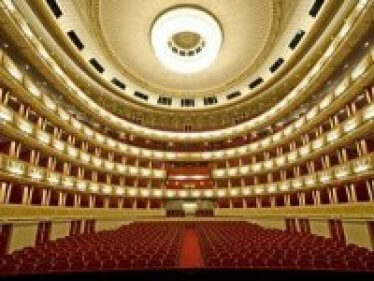Mahler, Live - Schedule, Program & Tickets
Mahler, Live
composer
Franz Liszt
choreography
Hans van Manen
Costumes
Keso Dekker
Light and production management
Bert Dalhuysen
Rehearsal
Rachel Beaujean
piano
Shaghajegh Nosrati
camera
Balázs Delbó
A woman alone on the big stage with her back turned to us. She wears a bright red dress and pointe shoes. A camera lying on the floor is aimed at her feet. A man joins it. He picks up the camera and lets it sweep over us - the audience. Thrown huge on a canvas, it is we who unexpectedly find ourselves as protagonists in the puzzle that Hans van Manen designed in the first video ballet in dance history: a sophisticated exploration of perspectives, distance and closeness. No other work from this period plays so masterfully with the mechanisms of perception and at the same time opens the space - namely when the dancer, of whom we initially only see the back while looking at us from the screen, leaves the stage towards the end of the piece, meets a Danseur Noble for a pas de deux in the foyer of the Vienna State Opera and then hurries off into the Vienna night.
Hans van Manen, born in 1932 in Nieuwer-Amstel, Holland, is one of those style-defining modern dance creators with his unique aesthetics who always amaze you. His choreography "Live" to piano music by Franz Liszt is an icon in dance history and so far belonged exclusively to the company for which Hans van Manen created it in 1979: Het Nationale Ballet Amsterdam. For his first premiere at the Vienna State Opera, the Dutchman is now entrusting his work to Martin Schläpfer, making it possible for another ensemble to perform it. An opening like an initiation, the experience of a historical work that is as relevant today as it was then - not only because we viewers are part of the whole.
Martin Schläpfer answers the intimate Hans van Manen miniature with only two dancers, a cameraman and a pianist in a contrasting way. "In order to make my debut as the new director and chief choreographer of the Vienna State Ballet, I do not want to shy away from any risk, go forward, work with the entire ensemble and the great State Opera Orchestra and thus fraternize the dance and musical area from the start," he explains. As the musical basis of his new work, he chose Gustav Mahler's 4th symphony completed in January 1901 as the conclusion of the »Wunderhorn« triad - a composition whose cheerfulness is only apparent, the idyll being disturbed from the start and the finale with it his "heavenly joys" by no means a transcendent vision of a heavenly paradise, but rather a bitter joke ...
Subject to changes.
Franz Liszt
choreography
Hans van Manen
Costumes
Keso Dekker
Light and production management
Bert Dalhuysen
Rehearsal
Rachel Beaujean
piano
Shaghajegh Nosrati
camera
Balázs Delbó
A woman alone on the big stage with her back turned to us. She wears a bright red dress and pointe shoes. A camera lying on the floor is aimed at her feet. A man joins it. He picks up the camera and lets it sweep over us - the audience. Thrown huge on a canvas, it is we who unexpectedly find ourselves as protagonists in the puzzle that Hans van Manen designed in the first video ballet in dance history: a sophisticated exploration of perspectives, distance and closeness. No other work from this period plays so masterfully with the mechanisms of perception and at the same time opens the space - namely when the dancer, of whom we initially only see the back while looking at us from the screen, leaves the stage towards the end of the piece, meets a Danseur Noble for a pas de deux in the foyer of the Vienna State Opera and then hurries off into the Vienna night.
Hans van Manen, born in 1932 in Nieuwer-Amstel, Holland, is one of those style-defining modern dance creators with his unique aesthetics who always amaze you. His choreography "Live" to piano music by Franz Liszt is an icon in dance history and so far belonged exclusively to the company for which Hans van Manen created it in 1979: Het Nationale Ballet Amsterdam. For his first premiere at the Vienna State Opera, the Dutchman is now entrusting his work to Martin Schläpfer, making it possible for another ensemble to perform it. An opening like an initiation, the experience of a historical work that is as relevant today as it was then - not only because we viewers are part of the whole.
Martin Schläpfer answers the intimate Hans van Manen miniature with only two dancers, a cameraman and a pianist in a contrasting way. "In order to make my debut as the new director and chief choreographer of the Vienna State Ballet, I do not want to shy away from any risk, go forward, work with the entire ensemble and the great State Opera Orchestra and thus fraternize the dance and musical area from the start," he explains. As the musical basis of his new work, he chose Gustav Mahler's 4th symphony completed in January 1901 as the conclusion of the »Wunderhorn« triad - a composition whose cheerfulness is only apparent, the idyll being disturbed from the start and the finale with it his "heavenly joys" by no means a transcendent vision of a heavenly paradise, but rather a bitter joke ...
Subject to changes.
There are no products matching the selection.


